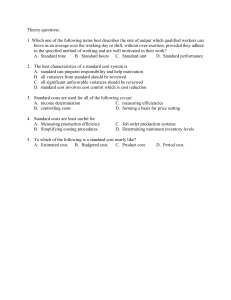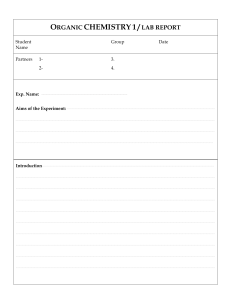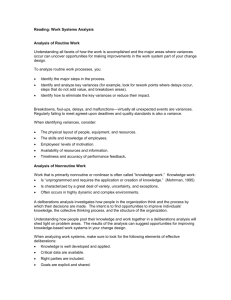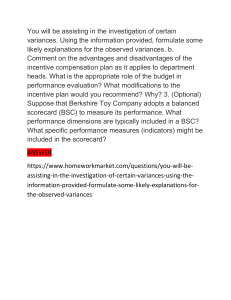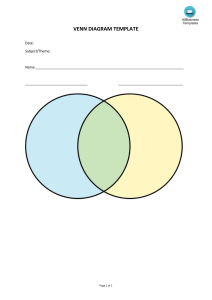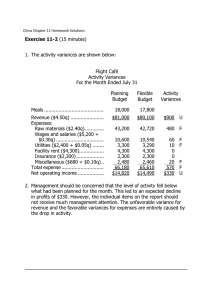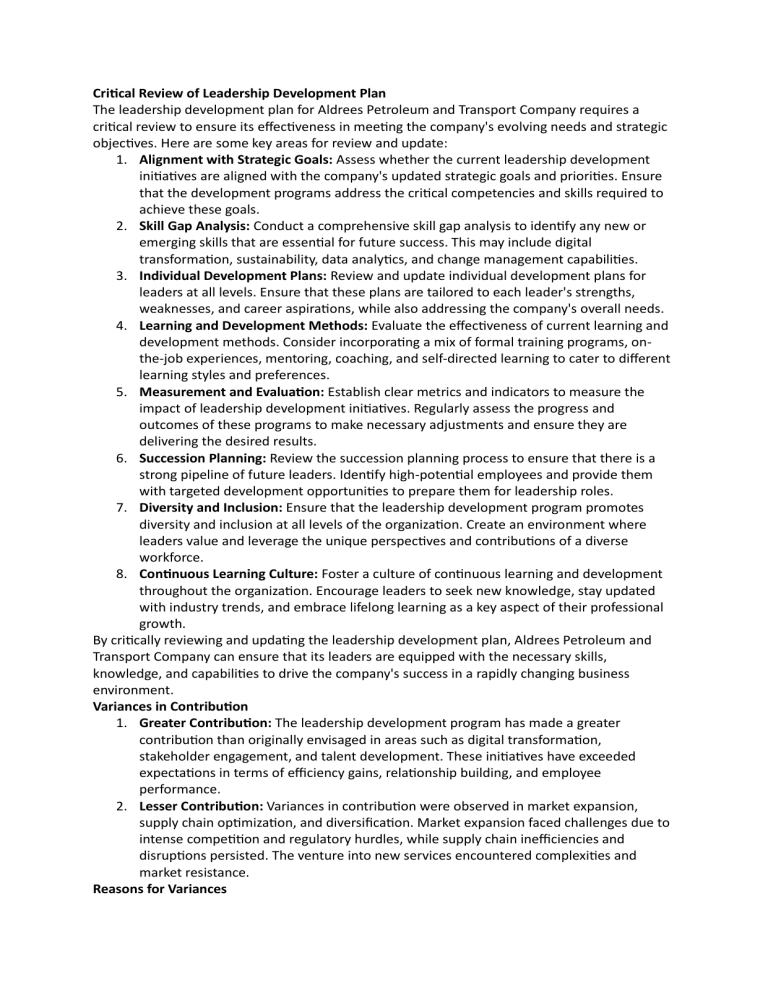
Critical Review of Leadership Development Plan The leadership development plan for Aldrees Petroleum and Transport Company requires a critical review to ensure its effectiveness in meeting the company's evolving needs and strategic objectives. Here are some key areas for review and update: 1. Alignment with Strategic Goals: Assess whether the current leadership development initiatives are aligned with the company's updated strategic goals and priorities. Ensure that the development programs address the critical competencies and skills required to achieve these goals. 2. Skill Gap Analysis: Conduct a comprehensive skill gap analysis to identify any new or emerging skills that are essential for future success. This may include digital transformation, sustainability, data analytics, and change management capabilities. 3. Individual Development Plans: Review and update individual development plans for leaders at all levels. Ensure that these plans are tailored to each leader's strengths, weaknesses, and career aspirations, while also addressing the company's overall needs. 4. Learning and Development Methods: Evaluate the effectiveness of current learning and development methods. Consider incorporating a mix of formal training programs, onthe-job experiences, mentoring, coaching, and self-directed learning to cater to different learning styles and preferences. 5. Measurement and Evaluation: Establish clear metrics and indicators to measure the impact of leadership development initiatives. Regularly assess the progress and outcomes of these programs to make necessary adjustments and ensure they are delivering the desired results. 6. Succession Planning: Review the succession planning process to ensure that there is a strong pipeline of future leaders. Identify high-potential employees and provide them with targeted development opportunities to prepare them for leadership roles. 7. Diversity and Inclusion: Ensure that the leadership development program promotes diversity and inclusion at all levels of the organization. Create an environment where leaders value and leverage the unique perspectives and contributions of a diverse workforce. 8. Continuous Learning Culture: Foster a culture of continuous learning and development throughout the organization. Encourage leaders to seek new knowledge, stay updated with industry trends, and embrace lifelong learning as a key aspect of their professional growth. By critically reviewing and updating the leadership development plan, Aldrees Petroleum and Transport Company can ensure that its leaders are equipped with the necessary skills, knowledge, and capabilities to drive the company's success in a rapidly changing business environment. Variances in Contribution 1. Greater Contribution: The leadership development program has made a greater contribution than originally envisaged in areas such as digital transformation, stakeholder engagement, and talent development. These initiatives have exceeded expectations in terms of efficiency gains, relationship building, and employee performance. 2. Lesser Contribution: Variances in contribution were observed in market expansion, supply chain optimization, and diversification. Market expansion faced challenges due to intense competition and regulatory hurdles, while supply chain inefficiencies and disruptions persisted. The venture into new services encountered complexities and market resistance. Reasons for Variances 1. Unforeseen Market Dynamics: Market expansion variances can be attributed to unforeseen market dynamics, such as increased competition and changing consumer preferences. 2. Implementation Challenges: Supply chain optimization faced challenges in implementation, including resistance to change, lack of resources, and inadequate planning. 3. External Factors: External factors, such as the COVID-19 pandemic and global supply chain disruptions, also contributed to the variances. Avoiding Variances in the Future 1. Continuous Market Analysis: Conduct thorough market research and analysis to identify opportunities and challenges accurately before market expansion. 2. Robust Supply Chain Management: Improve supply chain visibility, collaboration with suppliers, and contingency planning to mitigate inefficiencies and disruptions. 3. Phased Diversification: Adopt a phased approach to diversification, carefully evaluating each new venture's potential and ensuring adequate resources and market readiness. Cascading Learning 1. After-Action Reviews: Conduct thorough after-action reviews to analyze variances and identify lessons learned. Share these insights across the organization to inform future decision-making. 2. Knowledge Sharing: Establish platforms for employees to share their experiences, challenges, and successes, fostering a culture of continuous learning and improvement. 3. Mentorship and Coaching: Implement mentorship and coaching programs to transfer knowledge and skills from experienced employees to junior staff.

